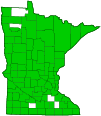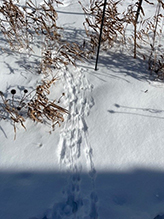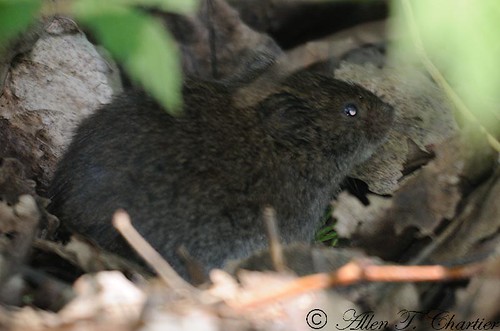meadow vole
(Microtus pennsylvanicus)
Conservation • Description • Habitat • Ecology • Distribution • Taxonomy
|
|
|||||||||||||
Description |
Meadow vole is the largest vole found in Minnesota and the most widely distributed mole in North America. It weighs between 1 and 2½ ounces. The length of the head and body together is The ears are small, inconspicuous, and hidden by the fur. The coat (pelage) is long and soft. It is dark brown on the back, a little lighter on the sides, and silvery on the belly. It is darker on young individuals, lighter on older individuals. The tail is |
Size |
Total Length: Head and body: Tail: |
Sign |
|
Similar Species |
Prairie vole (Microtus ochrogaster) pelage has a grizzled appearance. The belly is yellowish. The tail is shorter, |
Habitat |
Meadows, fields, grassy marshes, grassy woodlands. Moist places. |
Ecology |
Behavior |
Adults are active all times of day. |
Lifespan |
Less than one year |
Life Cycle |
Breeding takes place between April and December. Two to four litters are produced each year. There are usually 4 to 6 offspring per litter though there may be as few as 1 or as many as 11. Gestation lasts 20 to 23 days. Due to high nestling and juvenile mortality, an average of only 2.6 offspring are successfully weaned. The offspring reach sexual maturity at 5 to 6 weeks. Adults usually live less than one year but may live up to two years. |
Food |
Diet consists mostly of grasses, sedges, and herbs, but also includes seeds, grains, and when available, tubers, bulbs, and fruits. In the winter they sometimes eat the bark and roots of woody shrubs and trees. |
Distribution |
||
|
Sources Biodiversity occurrence data published by: Minnesota Biodiversity Atlas (accessed through the Minnesota Biodiversity Atlas Portal, bellatlas.umn.edu, 2/21/2025). Timm, R. M. 1975. Distribution, natural history, and parasites of mammals of Cook County, Minnesota. Occasional Papers, Bell Museum of Natural History, University of Minnesota 14:1–56. |
|
| 2/21/2025 | ||
Occurrence |
||
Very common |
||
Taxonomy |
|
Class |
Mammalia (Mammals) |
Subclass |
Theria |
Infraclass |
Placentalia (Placental Mammals) |
Magnorder |
Boreoeutheria |
Superorder |
Euarchontoglires (Primates, Rodents, and Allies) |
Order |
Rodentia (Rodents) |
Suborder |
Supramyomorpha |
Infraorder |
Myomorphi |
Superfamily |
Muroidea |
Family |
Cricetidae (hamsters, voles, lemmings, and allies) |
Subfamily |
Arvicolinae (voles, lemmings, and muskrats) |
Tribe |
Arvicolini |
Genus |
Microtus (meadow voles) |
Subgenus |
Mynomes |
Tribe Species Very few sources have adopted the revision. These include iNaturalist and Mammal Diversity Database. Among the sources that have not adopted the revision are Catalog of Life, GBIF, ITIS, Mammal Species of the World, and NatureServe. |
|
Subordinate Taxa |
|
Acadian meadow vole (Microtus pennsylvanicus acadicus) arctic meadow vole (Microtus pennsylvanicus arcticus) bean meadow vole (Microtus pennsylvanicus wahema) black meadow vole (Microtus pennsylvanicus nigrans) Block Island meadow vole (Microtus pennsylvanicus provectus) Chihuahua meadow vole (Microtus pennsylvanicus chihuahuensis) Pennsylvania meadow mouse (Microtus pennsylvanicus pennsylvanicus) Hudsonian meadow vole (Microtus pennsylvanicus fontigenus) large Labrador meadow mouse (Microtus pennsylvanicus enixus) little Labrador meadow mouse (Microtus pennsylvanicus labradorius) Magdalena Island meadow vole (Microtus pennsylvanicus magdalenensis) meadow vole (Microtus pennsylvanicus copelandi) Newfoundland Island meadow vole (Microtus pennsylvanicus terraenovae) Penobscot meadow vole (Microtus pennsylvanicus shattucki) |
|
Synonyms |
|
Arvicola alborufescens Arvicola dekayi Arvicola drummondii Arvicola fulva Arvicola hirsutus Arvicola insperatus Arvicola nasuta Arvicola oneida Arvicola palustris Arvicola riparia longipilis Arvicola riparius Arvicola rufescens Arvicola rufidorsum Arvicola terraenovae Lemmus noveboracensis Microtus admiraltiae Microtus aphorodemus Microtus drummondi Microtus enixus Microtus fontigenus Microtus insularis Microtus montanus Microtus nesophilus Microtus pennsilvanicus shattucki Microtus provectus Mus pennsylvanicus Mynomes pratensis |
|
Common Names |
|
meadow vole |
|
Glossary
Pelage
The coat of a mammal, consisting of fur, wool, or hair, and including a soft undercoat and stiff guard hairs.
Visitor Photos |
||
Share your photo of this mammal. |
||
This button not working for you? |
||
Val McGruder |
||
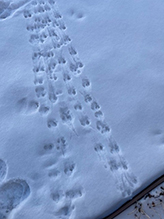 |
||
animal tracks I believe these are Western Meadow vole tracks. |
||
MinnesotaSeasons.com Photos |
||
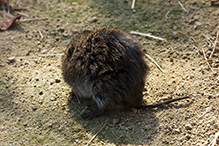 |
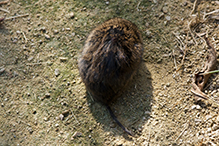 |
|
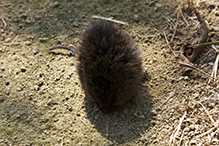 |

Visitor Videos |
||
Share your video of this mammal. |
||
This button not working for you? |
||
|
Other Videos |
||
Meadow Vole (Cricetidae: Microtus pennsylvanicus) |
About
Published on Feb 24, 2013 Photographed at the Turtle River State Park, North Dakota (23 February 2013). |
Meadow vole at the "Good" field, Bryn Athyn College campus |
About
Published on Apr 5, 2013 The meadow vole (Microtus pennsylvanicus) at the "Good" field, Bryn Athyn College campus was busy marking the camera in a clipped grassy pathway (run). |
Meadow vole running in a panic (HD) |
About
Published on Jul 23, 2012 A meadow vole (Microtus pennsylvanicus) climbed in a plant and started gnawing the stem. When the stem breaks and falls down, the vole runs in a panic and doesn't return. Quite hilarious, and an indication for limited intelligence. This is one meadow vole that certainly won't be doing calculus any time soon. |
Jack Hubley's Mightiest Mammal -- The Meadow Vole |
About
Uploaded on Apr 2, 2010 The Susquehanna Valley's mightiest mammal may not be the big, bad creature you might think |

Visitor Sightings |
||
Report a sighting of this mammal. |
||
This button not working for you? |
||
Val McGruder |
Location: Minnetonka, Minnesota I believe these are Western Meadow vole tracks. |
 |
| Viner 66 1/13/2020 |
Location: St. Louis County, Minnesota So many trapped in my garage, it feels like an infestation. |
|
MinnesotaSeasons.com Sightings |
||

Created: 10/1/2012 Last Updated: © MinnesotaSeasons.com. All rights reserved. |
